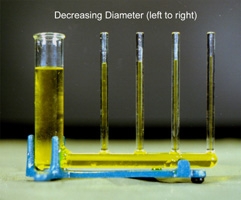What it shows:
 Due to surface tension effects water rises up a narrow bored tube; the rise in height being inversely proportional to the bore's radius.
Due to surface tension effects water rises up a narrow bored tube; the rise in height being inversely proportional to the bore's radius.
How it works:
The setup shows the direct comparison between four capillary tubes of different bores. The tubes, with bores 3, 2, 1 and 0.5mm respectively, are held together by tubing clamps and sat vertically in a watch glass containing ink and water (see figure 1). Capillary action draws the ink/water up the tubes to varying heights.
figure 1. Capillary tubes in action.

Setting it up:
Clamp the tubes to a lab stand and lower them into a petri dish. It is best to mix the ink and water before setting down the tubes. Be generous with the ink (black, blue or red); the setup needs to be illuminated from behind with a light box, and the level in the thinnest tube is especially difficult to see. Use a CCD camera with close-up lens looking as horizontally as possible; the watch glass should sit on a lab jack so a suitable view can be obtained.
Comments:
As already mentioned, it can be difficult to see the water levels in the capillaries because of the thin optical depth. Play around with the camera angle to get the best contrast on the monitor.